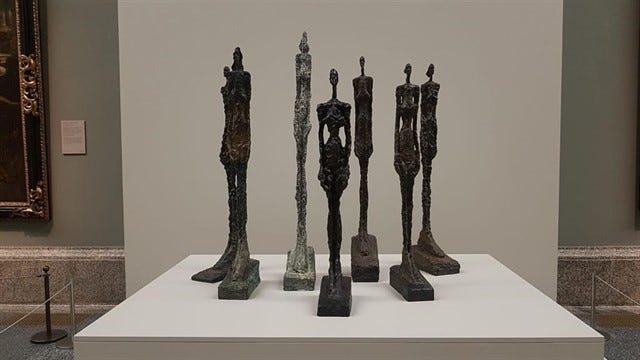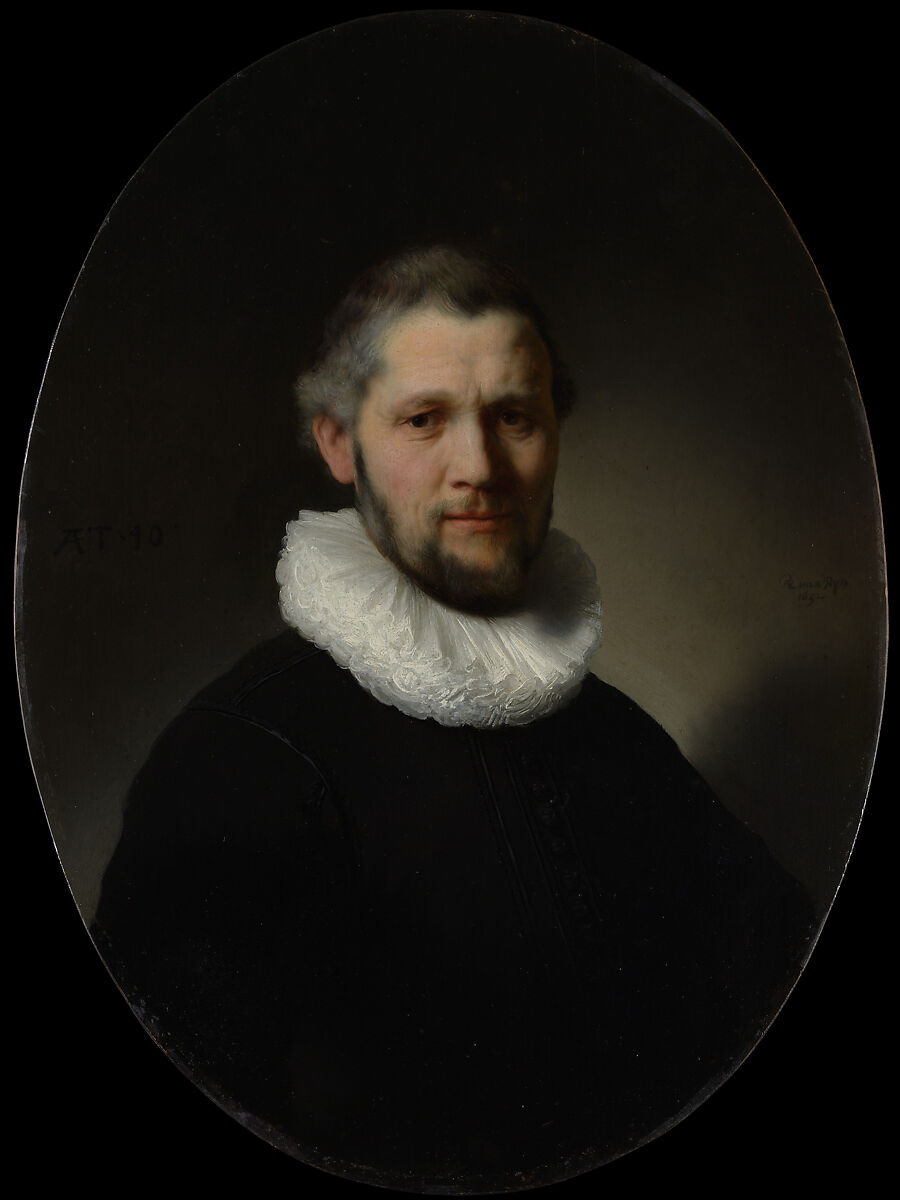28 SEPTEMBER—Standing before the emaciated, impossibly elongated—“stretched too thin”—human figures of Swiss sculptor, Alberto Giacometti, recently on display at the Museum of Modern Art, I felt their complete pertinence to our time. They are commanding. At once beautiful and frightening, they evoke precisely my feeling when walking the streets of New York where I feel invisible, reduced to a mere object, or to nothing at all, as hundreds of people stream past.
Walking the streets of New York: All of us seen and not seen. All of us seeing and not seeing the people coming straight at us, people we do not acknowledge or recognize, except of course for a small deft sidestep.
The faces of each person in this great multitude are little more than masks—as undoubtedly is mine—rendering them in some sense all the same. Anonymous. Little if any emotion registers on them as, like the faces of Giacometti’s hollowed-out figures, they stare straight ahead. Never do I feel more alone or alienated, more nearly inhuman, than when navigating the streets and sidewalks of New York, or any of the world’s inhumanly vast cities.
There is for me—having grown up in a small rural community, with all the associated bonds and ties, surrounded by earth and all that grows and lives upon it—something altogether unnatural and even terrifying about so many people living crammed together and atop one another in a polluted, noise-filled, sprawling alien ecosystem of concrete, steel, and glass. To my ears, it is as if the city itself screams and no one hears.
Curiously, ironically, perhaps even indecently, it is those living on the street who seem most human—human in being anomalous and so obviously and disturbingly not a part of the nameless, faceless crowd. The incongruous behavior and dress—one man sat in the middle of the sidewalk, in the same place each of the two days I passed him, surrounded by his few possessions, hunched over a book reading—forcing the crowd to part like the Red Sea around him—invites us finally to look and to see, to acknowledge and recon with, their humanity and, perhaps most importantly, our own.
Giacometti began his iconic sculptures in Paris in 1945, within a year of the city’s liberation and the end of WWII. His human forms emerged from the anomie surrounding them. And so they mirrored the complete hollowing-out of Europe, and indeed of humanity during that terrible time. They stand completely isolated and alone, ghost like and lost.
The Existentialist philosopher Jean-Paul Sartre said of Giacometti’s sculpture that they were “always halfway between nothingness and being.” This seems to precisely describe what must have been the postwar experience as people walked about in a state of deep shock, and tried to recreate lives from what little remained of their towns and countries, their families and communities—and themselves.
Halfway between nothingness and being fairly describes the fragile human condition. It is a state—physical and psychological—at once fearful and full of possibility.
A day later, my last in New York City while on a short stopover, I walked forty blocks to the Metropolitan Museum of art to see a traveling collection of Dutch Masters. It is not the period or style that most interests me, but on that day I was curious to look at paintings I had never before had the opportunity to see in person. Most of the paintings left me cold, until I found myself standing before Rembrandt’s, Portrait of a Man, painted in 1632.
There, in a painting nearly 500 years old, I saw a depiction, not only or maybe even primarily of an individual man, but, rather, of all humanity. Tears came to my eyes, spilled over and ran down my face. Rembrandt had captured at once the sorrow and joy, the unbearable sadness and fleeting delight, that mingle in every human heart. I stood for long minutes before it, walked away to see other paintings, other Rembrandts of equal virtuosity, then came back to gaze again at the painting that had so moved me.
And then I turned to look at the wall opposite, a wall I had missed on my first pass through, and hanging there I saw two of my favorite paintings by Vermeer. Paintings I had never thought or hoped to see in person. Tears threatened again to flow. It is one thing to see reproductions of a masterwork, but altogether another to stand before the actual thing. Something of the presence and energy and life of the painter inhabits the canvas, captured in the very brushstrokes.
With only an hour left, I wanted to see a second show of early Buddhist artwork and had no idea where to find it. With map in hand I approached the dour museum guard watching over the Dutch Masters. She was short and blond, dressed in black trousers and blazer, and stood at stern attention along one wall. I’d asked her a question an hour earlier and found her terse and unfriendly.
“Excuse me,” I said with some hesitancy, “may I ask another question?”
She looked at me. But instead of asking for directions, I heard myself commenting on the show, and how it had moved me. And then I asked, “Which of the paintings is your favorite?”
In reply, a smile lit her suddenly beautiful face and she said, “The Portrait of Gerard de Lairesse.” She explained why at some length and then said, “Several years ago, I stood in front of the Mona Lisa and didn’t feel a thing. Then I saw David (Michelangelo’s monumental statue of King David) and I fell in love.”
“I sometimes watch people stand for ten minutes in front of a painting and I never say anything. I give them all the time they want because you never know. You never know which painting will move them. It could be the very last painting they see of the day. The very last painting they see might be the one that makes them fall in love.”
We spoke for several satisfying moments. She pointed out on the map where to find the Buddhist show, circled the impressionist rooms that were nearby with a pen—where it turned out, I spent my remaining time—took out her phone and showed me how to access the MET’s online virtual shows. Then she smiled and said, “I’m here if you need me again.”
Art matters because it touches and moves us. It speaks to us on levels beyond words and even thought. It is as if, when looking at art we gaze into a mirror and see ourselves reflected back—a reflection at once clearer and more wondrous than before—a human face with eyes that speak of all a human heart can hope, and feel, and hold.
Note: Everything I write and publish here is free and free to share. If you like what you read and want to support my work, you can make a donation through PayPall using my email, sangwayeshe@gmail.com, or, by subscribing to Our Journey. Thank you.







First of all, I'm sorry but...paypal is not spelt paypall. I'll bet you put that in there on purpose.
Your observations are interesting. I, too, think of the city as cold and hard. And I was going there in the late 60s when the population was just shy of 8 million. By contrast, when I lived there, Tehran had a population of 4 and a half million but it didn't seem cold or hard – even in the bazaar which was normally packed to the gills with people buying everything under the sun everything from gold to Isfahan cloth to live chickens. Tehran is a much more human place.
Your description of the guard strikes me as typical for a place like NYC. People's guards are up until there is something that you have in common. Then they can be human. Also seeing the actual piece of art is different than seeing a reproduction and there is, after all, a reason that they are called old masters.